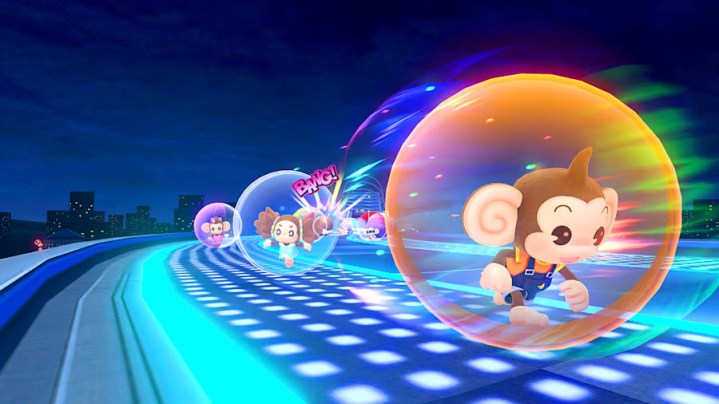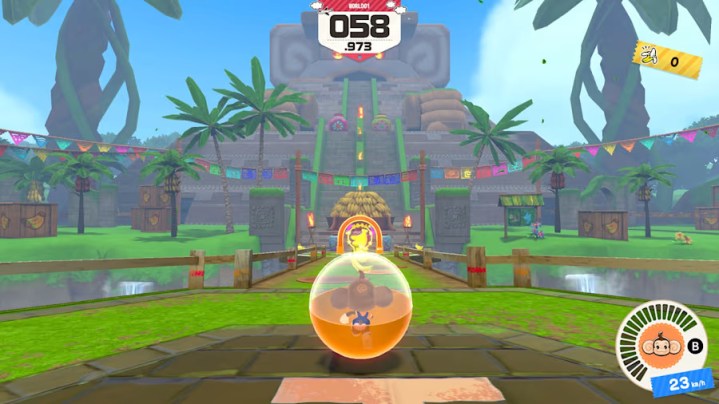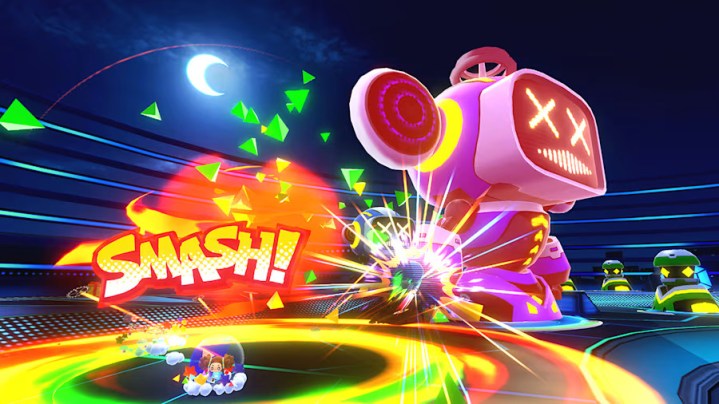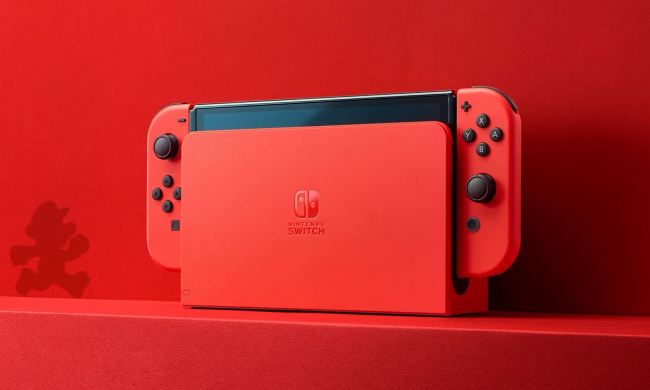
I couldn’t tell you what the last Super Monkey Ball game I played was, but I can still talk your ear off about the series. That’s thanks to the speedrunning community that has formed around the franchise, making it into the most exciting game to watch when it’s played at a high level. After spending close to a decade watching old games turned inside and out, I’m ready to finally dig into a new entry for myself.
Thankfully, I’m getting that chance on June 25 when Super Monkey Ball: Banana Rumble launches on Nintendo Switch. The latest entry in Sega’s precise platforming series comes loaded with content, from an adventure mode with 200 stages to multiple 16-player multiplayer modes. That’s all exciting, but my attention was on one question when I sat down to demo all of that last week: How fun will it be to watch players master it?
The answer? Very, very fun.
Gotta go fast
Super Monkey Ball: Banana Rumble is a fairly robust package compared to some previous entries. Its story mode is packed with true cutscenes, and there are a wealth of creative multiplayer modes, lots of monkey customization options, a shop, alternate characters with their own stats, daily missions, and even a leveling system. You can see how seriously developer Ryu Ga Gotoku Studio (the same developer behind Like a Dragon) is taking this installment when you pop open the settings menu. There, players can adjust the most minute of details, down to setting dead zones for their joysticks. This isn’t a nostalgic cash grab; it’s as serious as can be.
Before gong hands-on myself, I’d get the exact experience I wanted: the chance to see someone else play it. In my session, a fellow press member started things off by playing through a handful of adventure mode levels. The story-driven mode is familiar, sending players through a bunch of maze-like platforming challenges that they must carefully navigate with their ball. The added twist this time around is that the monkeys have a spin dash that can be charged up and released for a speed boost.

If you, like me, have ever seen Super Monkey Ball played quickly, you can already guess how exciting that addition is. I’d watch on as my buddy tried to zip through levels as fast as possible, snagging bananas en route to each level’s end goal. While players only have 60 seconds to complete that task, the levels I saw can be completed much quicker with some reckless determination. But it’s the spin dash that takes that idea to the next level, opening the door for high-level shortcuts that can slash a stage’s completion time down to mere seconds.
In one stage’s intended route, players are supposed to snake around a long maze while navigating platforms that move in and out of the ground. I wouldn’t see that solution. Instead, I’d get to watch the other player try to spin dash onto a platform right near the starting line as it was rising and launch through the air to create a huge shortcut. Another stage sent him down a rickety wooden slide that called for some careful speed control. Instead, he tried to boost right off the top and bypass the entire thing. I enthusiastically cheered on from the sidelines just as I do whenever I watch a speedrun.
While it’s clear that Ryu Ga Gotoku Studio kept the speedrunning community in mind when making Banana Rumble, it isn’t alienating casual players. The game contains tons of handy assists meant to make the precise platforming more forgiving. That feels like the right balance. Those who just want to enjoy the adventure mode with minimal frustration will get that. For those who really want to break levels down to a science, though, Banana Rumble offers some fantastic tools to make it happen.
16-player mayhem
When I finally got to try it for myself, I’d pop into Banana Rumble’s suite of multiplayer battle modes. Each mode, which can be played with 16 players total, offers its own chaotic spin on the platforming formula. The most straightforward mode is Race, which has players going head-to-head to see who can finish a long obstacle course first. In a Mario Kart-like twist, players can also grab battle items that can mess with other players. One turns nearby rivals into giant weights, cutting down their movement speed temporarily. Others grant speed boosts or protective shields.
The modes only get more enjoyably hectic from there. One has all 16 players fighting to collect the most bananas on a time limit, while another has two teams smashing robots by boosting into them to get points. The most fun modes feel like great Mario Party minigames. One puts me in a five-round game of hot potato where players pass a bomb to one another by knocking into each other. Another sends two eight-player teams down a long slope filled with gates, each one with its own point value. My team fights to claim the most gates and get the most points by extension, taking some big risks to try and nab valuable gates near the end.

Of course, none of these charming ideas would work if Banana Rumble didn’t control well. Thankfully, there are no issues there so far. While die-hard GameCube players may notice differences, the physics feel right to me so far. I can move smoothly and speedily, and it’s easy to launch myself off obstacles and control myself in the air. My crowning achievement comes during a round of hot potato where I manage to pass my bomb off at the last second, while just barely sailing over a player holding another bomb. That razor-thin moment speaks to how well the controls allow for those body-clenching moments of tension.
Even if Super Monkey Ball: Banana Rumble doesn’t bring the series back into the mainstream spotlight, it feels like a worthy installment for new and old fans alike. The mix of strong accessibility options paired with some high-level speediness seem like they’ll make for a lot of depth. And while I’m sure I’ll have fun playing it myself, I’m even more excited to see how fast players can tear it apart in the years to come.
Super Monkey Ball: Banana Rumble launches on June 25 for Nintendo Switch.



